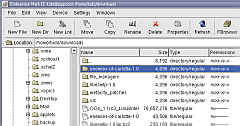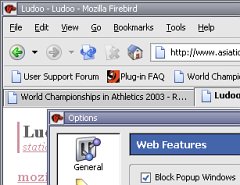
Today I intended to write a comparison of a few Gnome filemanagers I downloaded and tested this morning, but it's late and going to bed is starting to look like an attractive option.
And tomorrow I'll go to San Siro (or as it's called now stadio Meazza) to see Inter's debut match for this season, so I suspect I won't feel like writing the article either.
So a short entry is in order. Trying to find a speedier and hopefully more usable alternative to Nautilus, I downloaded three file managers:
Velocity looks promising though it makes quite a mess if you let it manage your desktop, or change a folder icon. It also lacks basic things like a detailed view of files, with dates sizes etc (or if it's there, I could not find it easily enough). No screenshot here, since it basically looks like Nautilus with a working directory tree in the sidebar.
The Gnome File Manager is a very quick, basic Norton Commander look-a- like. It has what you expect from a similar program. Not having much, it does not miss much, apart from context menus to perform basic actions with the mouse instead of hitting the F-keys, a status bar displaying the available F-keys commands like its ancestor has, and drag and drop. No screenshot here either, since it's look is very plain and similar to most of its relatives.
Endeavour is the best of the three. It's a feature-rich file manager, with special modes for archives and images, and tools to search for files and mount/unmount disks. I managed to lock it a few times with the open with menu entry for file items, and could not manage to make its archives mode work too well, but on the whole it's a beautiful and feature-rich application and I suspect that if you spend some time customizing it, it may work well.
In the end I did not use any of the three file managers, and did what I had to do from the shell, as usual. =)
Yesterday I went to Sun Microsystem's Milan offices, to see a presentation on Sun Ray, their thin client architecture, and a running example of their new Linux desktop, Mad Hatter.
I have to say I was a bit skeptical about the whole thing, the presentation had been arranged almost a couple of months ago and I had totally forgotten about it. From what I had heard about Mad Hatter in previous meetings, I was not convinced it could add any benefits compared to other corporate-oriented Linux distributions, apart maybe for a single source of support.
Moreover, I had already been bitten a few years ago by Sun's thin clients, when I convinced the company I worked for to buy a few JavaStations for testing, and after fiddling with them a while we found them completely useless (or at least not up to the hype that was surrounding them).
Plus, after the summer vacations schedules are still a bit fuzzy around here, so I was lucky one of the sales engineers called be the day before yesterday to remind me of the meeting, or else I would have totally forgotten it.
Despite all this, the presentation turned out to be very interesting. I came out of Sun's building totally impressed by what I had seen.
Sun Ray is a wonderful architecture. The clients are beautiful and sufficiently fast, sessions get transparently restored across geographical networks, and with Solaris supporting Gnome you feel right at home in Sun Ray's desktop. Moreover, rumours say the server software that controls the thin clients will soon be able to run on Linux, giving you the option of using 386 servers instead of expensive (but reliable and beautiful) SPARC servers.
After the presentation, the Sun people let me play around a bit on a couple of Sun Rays, one attached to a guest network, one attached to Sun's worldwide network. The real thing was even better than the presentation (which was very interesting already), and that's not something you see often.
Now I'm trying to convince my boss to spend some money on a start-up bundle (15 Sun Rays and a small Sun Server for 8k euros), so that we can properly test them. Unfortunately, we're becoming more and more Microsoft-oriented at least on the desktop side of things, and technology decision are usually based on politics rather than technical merits, as is always the case in huge organizations.
As for Mad Hatter, I had a quick look and was favorably impressed. It is based on SuSe, not on RedHat as they told us a couple of months ago. It sports all the usual apps, Star Office (ofc), and a beautifully themed Gnome Desktop. What surprised me is that the Gnome packages are pretty bleeding edge. I was prepared to find the usual corporate-oriented distro, ie slow to accept changes and favouring old and stable packages vs new and potentially unstable ones. Instead, the feel of Mad Hatter is of something built by affectionate developers, with a very careful eye towards the professional user's needs.
I'm very curious to see how it feels using it on a day-to-day basis. I hope we're able to join the beta test in a few weeks.
To sum it up, a well spent and interesting morning, in a beautiful (if empty -- we crossed lots of rooms without seeing anybody around) space, with very kind and knowledgeable people (they even let me play a bit on a Mac OSX system they had lying around, lol).

I tried Mozilla Firebird as soon as it was announced, and was not impressed enough to switch from Mozilla. Plus, I was using Mozilla Mail as my email client, and it felt a bit funny to use something else as a browser.
Lately I started using Evolution, which I like a lot apart from some minor annoyances (no context menu in the message pane for copying, poor LDAP support compared to Mozilla Mail), so I went around shopping for a new browser.
I tried Epiphany, which is still a bit rough, and Galeon. One or the other of them messed up my Mozilla installation (on two different machines, so it's not a localized issue) so much that I had to wipe it and reinstall it from scratch.
This morning while having breakfast an entry on AMK's Diary mentioned Burning Edge, a Mozilla/Firebird blog where new builds are announced daily. I went to have a look and there's a Linux+gtk2+xft nightly build. I installed it and liked it so much it's now my default browser. Definitely recommended, if you can overcome the .rpm .apt addiction and simply untar an archive somewhere. Of course, using Slackware I'm not annoyed by these things. =)
update: mainly as a bookmark for myself, Firebird packages for Slackware 9.0 are available at pryan.org